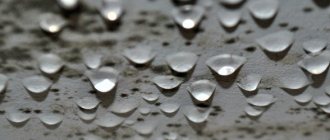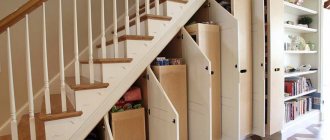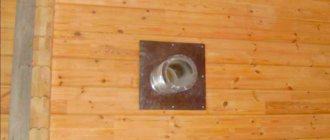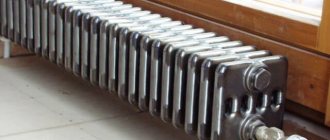Wet walls in a private house or apartment are not just an unpleasant phenomenon. The base begins to darken, the finish deteriorates, and fungus and mold appear. Due to wet walls, the microclimate inside the room worsens, and it is cold in winter. If fungus develops, simply scraping it off will not work. This increases the cost of repairs. In addition, dampness negatively affects human health. Before you fix the problem, you need to consider the reasons for its occurrence.
The main reasons why walls become damp
To find out why a wall gets wet, you need to understand that there are obvious and hidden factors. The reasons for the problem are:
- water gets inside through cracks in the base or from the attic, eaves, or drainpipe;
- a wall in a private house becomes wet due to insufficient thermal insulation;
- the room is poorly heated;
- the ventilation system does not perform its functions properly;
- foundation waterproofing was carried out incorrectly;
- brick walls get wet if washed clothes are often dried in the house;
- there is no hood in the kitchen or bathroom;
- small thickness of external walls;
- the presence of voids inside the seams or floor slabs;
- a large amount of water in the basement;
- excessive cooling of the base due to the presence of reinforcement.
The wall in a private house becomes damp also because the balcony slabs do not connect well to the base. Improper vapor barrier also leads to condensation on the pipes.
Recent renovation
After carrying out repairs using plaster mixtures or putties, the problem of wet walls arises. These finishing materials contain a large amount of water, which is absorbed by the base. This phenomenon is normal, and the moisture remains inside the walls for some time. The problem is also caused by poor ventilation of the room during renovation work.
If in this case the wall gets wet, the problem goes away on its own within a week. You can speed up the process if you constantly ventilate the room. The use of heaters or other technical devices is not always permitted.
External moisture
If a wall becomes damp, the reason for this is often insufficient waterproofing. Moisture can seep through the smallest cracks, accumulating inside the base. The walls in a panel house get wet more often than in buildings made of other materials. The weak point here is the seams between the slabs. If the construction technology is violated, their depressurization occurs.
If the walls of a house on the upper floors become wet, this is caused by poor quality of the drainage system, improper installation of the roof covering or insufficient level of roof waterproofing. Most often, moisture spots can be seen in spring and autumn, with the arrival of the rainy season.
Insufficient ventilation
If the walls in an apartment get wet, the reason for this is often a malfunction of the ventilation system. Most often, older buildings face this problem. This is indicated by foggy windows, the formation of condensation on the walls behind the curtains, as well as on nearby objects. Air circulation and microclimate in the apartment deteriorate.
You can detect the problem by checking the efficiency of the ventilation system. To do this, open the window and apply a sheet of paper to the grille. If it sticks and does not fall off, then the system is working properly. If functionality is impaired, it needs to be cleaned or redesigned. Particular attention is paid to the hood in the bathroom, since this room is deaf.
High indoor humidity
Regardless of whether dampness appears from the inside in winter or in other seasons, the reason for this is often the increased level of humidity inside an enclosed space. This occurs due to the presence of a large amount of fumes, as well as the installation of plastic windows that increase the airtightness of the room.
Wall freezing
The walls in the apartment may become damp due to freezing. Most often, this situation occurs in an old brick house. Previously, the process of insulating structures was practically not carried out, so at negative temperatures in winter they freeze. In this case, moisture is always present on the walls, and the building is cold, despite the heating. The costs of heating living rooms are rising.
If there is a wet wall in the apartment, this indicates a shift in the dew point in the wall closer to the room. If heating is poorly organized, this leads to the structure sweating. So, why the wall in the building becomes damp is already clear. Now we need to figure out how to deal with the problem.
By the way, are the boards impregnated with bioprotection?
In theory, all your subfloor boards should have been treated with bioprotection before installation. Note that this does not prevent mold from forming on top of the boards. But if biosecurity has not been done at all, treatment needs to be carried out. Be sure to use a respirator and be extremely careful under the floor, staying as little in the underground space as possible.
That's probably all. It should work. If you can offer your ideas, materials and actions to get rid of dampness under the floor, please send them by email for publication here.
PS What if nothing helps? — Try forced ventilation. In stores that sell all kinds of fans and ventilation pipes, you can buy a fan - from the simplest one, which is placed in the bathtub at home, to more powerful ones. You can try the simplest one, but it will be of little use (although for small areas the effect will also be noticeable after a day or two of work). Insert the fan into the hole in the foundation from the inside so that it draws air out, make an extension cord and run it for a long time. You can also put a heat gun in the underground and try to dry it with it. It is clear that you will not turn it on all the time, only temporarily and not forgetting about electrical safety in a damp room.
PPS Once again, I would like to draw your attention to the fact that it is worth installing hatches in the house when constructing the floor. And in such quantities that you can climb through them into the desired part of the room. However, remember that in winter these hatches will require insulation, so do not overdo it.
(c), Nick Masterov, especially for ELport.ru
Ways to get rid of dampness
What to do to get rid of the problem, you need to decide on your own, taking into account the cause of its occurrence. Sometimes it is enough to ventilate the premises more often; in other cases, redesign of the heating system or radical measures are required.
Getting rid of external moisture
If you know why the base is getting wet, you need to start immediately solving the problem. Ventilation and electric heating will only partially correct the situation. It is better to take the following measures:
- Isolation of the weak area. Before treating a wet spot, you need to find a weak spot through which moisture enters. It is insulated with bitumen mastic. The wet finish will have to be removed, the area dried, a deep penetration primer or antiseptic solution applied, and then the wall plastered or covered with wallpaper.
- Elimination of leaks. This is done by special services. It is not always enough to simply patch a hole. Pipes have to be replaced more often.
- Treating the floor if there is a basement underneath the room. To do this, use a deep penetration primer or insulating solutions that penetrate into the smallest pores of the concrete floor slab and clog them. After this, a waterproof base is laid on the base, and the joints are sealed.
- High-quality sealing of joints between the balcony slab and the wall. In this place, not only moisture penetrates into the room, but also cold.
- Foundation insulation. If groundwater rises more than 1.5 m, moisture penetrates inside the walls. In this case, the structure will become damp from below, in the corners, under the baseboard. High-quality horizontal insulation will help correct the situation.
If you seal the seams in only one apartment, over time the problem will appear again. Joints need to be insulated throughout the house.
Restoring ventilation
If the wall of a brick house gets wet and the ventilation is not working well, then this problem can be solved in several ways. If there is a local malfunction of the structure, you just need to move the cabinet or curtains. To remove a ventilation blockage that is located near the grille, you can use a vacuum cleaner. To properly organize traction in a private home, expert advice is required.
Redevelopment of premises in brick or panel buildings on the upper floors often leads to disruption of air flows. If the draft is not normalized, then slits need to be made at the bottom of the door. This will improve air circulation.
To make damp walls dry faster, you can organize forced ventilation. The device is installed in the bathroom instead of a grille. The same device is installed in the kitchen. The fan is sometimes equipped with a timer and a check valve. The hood is checked every 3-4 months.
Elimination of high humidity
Walls can become damp due to the influence of internal factors. In the absence of insulation and poor performance of the heating system, moisture in the rooms will increase even more. To eliminate the problem, additional or alternative sources of thermal energy are needed.
If plastic windows are installed, there is insufficient ventilation in those places. Therefore, ventilation is mandatory.
Elimination of freezing
Being in a damp and cold room is not only uncomfortable, but also dangerous to your health. There are several ways to deal with the problem. The first of them is stronger heating of the room. However, its disadvantage is the increase in heating costs.
It is more effective to insulate the house from the outside. If polystyrene foam is used for work, then re-insulation from the inside is not used, since the dew point moves closer to the room. Moisture will accumulate under the insulation, which will lead to the development of fungus and mold, which will worsen the problem.
Thanks to external insulation, the dew point is in the right place. This process is expensive but effective. If internal insulation is not required, then correct thermal calculations are important, otherwise dampness will increase and the insulation material will get wet, which reduces its effectiveness. The indoor microclimate is deteriorating.
If the thickness of the walls is insufficient, then the situation can be corrected with the help of an additional layer of cladding. Brick is used for this.
Mold control
Mold poses a respiratory hazard and must be eliminated quickly. To do this, the following procedures are carried out:
- First you need to remove the facing layer. The work is carried out in protective clothing, as well as a respirator, so that dust with microparticles of mold does not get into the lungs. Contaminated areas should be removed using a wire brush or spatula.
- Antiseptic treatment. To do this, you can use improvised means: vinegar, bleach or baking soda. The best option is to use professional products.
- 2-3 hours after treating the wall, you need to walk over it with a dry brush. This will eliminate the breakdown products of microorganisms. After this, the base is washed with warm water and dried thoroughly. Here you can use technical devices.
- After 24 hours, the surface is coated with a deep penetration primer. Several layers of liquid are applied.
- Plastering the base. It is better to choose a material with water-repellent and antifungal properties.
Lastly, the walls are finished. To do this, use wallpaper or paint.
About the monolithic domed house
This “rational consistency” is fully possessed by the monolithic concrete dome. And one more thing: it has the heat capacity of the shell.
But everything is in order. We make calculations for certain sizes.
Heat transfer resistance.
Design - Dome - R-5m, D-10m, h5m, Sfloor = 78.5m2, Ssphere = 157m2, Vppy = 157 x 0.15 = 23.5m3, Vbet = 157 x 0.10 = 15.7m3.
The building is in constant use. Type of structures – two-layer external wall:
– 0.15 m polyurethane foam; 0.10m reinforced concrete; dry mixture density go = 1500 kg/m3; concrete wall density = 2720 kg/m3.
Calculated thermal conductivity coefficient L = 1.0 W/(m°C); heat capacity coefficient = 0.84 kJ/(m2•°C); polyurethane foam - as external insulation.
Application thickness = 0.15m. Density = 55 kg/m3. Calculated thermal conductivity = 0.027 W/(m°C); Rb = 0.10 m / 1.0 W/(m oC) = 0.1 0 C/W; Rpp = 0.15 m / 0.027 W/(m oC) = 5.555 0 C/W; Rwall = 0.1 + 5.555 = 5.6550 C/W.
The total heat transfer resistance of a wall in a monolithic domed house is 5.6550 C/W.
What does the resulting figure mean - Rwall = 5.6550 C/W?
First of all, she will show us where and at what depth the “armored personnel carrier” will be hiding in the wall.
This location will be at a distance of = 5.655 / 2 = 2.83. Those. closer to the middle of the thermal layer.
The heat transfer resistance of the PU foam shell being calculated is 5.555. And, if we subtract the value = 2.83 from it, we get the visible location of the “dew point” in the polyurethane foam layer. It will be located somewhere at a depth of 6.5 cm.
At the junction of polyurethane foam and concrete of a domed house there will always be a positive temperature.
This guarantees the durability of the structure and comfortable living conditions at minimal cost.
Even if it is -400 C outside, and only +20 C under the dome, the “dew point, aka “0”, will not reach the concrete shell, stopping two centimeters away.
The concrete shell of the dome is reliably protected from any temperature changes. And the polyurethane foam layer is reliably protected from external influences.
Where to go when the walls become damp
Before contacting utility services, you need to determine the cause of the dampness. If you can’t do this yourself, you can call a specialist from the organization managing the apartment building. Before starting work, a report is drawn up. It is issued in the presence of the owner of the apartment, two witnesses and a representative of the organization. This document can be submitted to any other authorities.
If the activities of the management company are not the cause of dampness on the walls, then you will have to hire private craftsmen. In another case, a written claim or complaint is submitted to the housing maintenance office. The organization must review it and respond within a week. After this, specialists should begin to fix the problem.
If the management company refuses to carry out repairs, it will notify the applicant in writing. When inspecting an apartment, a specialist can determine that dampness appears due to the action or inaction of the operating organization; the affected party can contact the following authorities:
- Housing Inspection;
- Rospotrebnadzor;
- Prosecutor's Office;
- Local administration.
The complaint must be properly formatted. In accordance with the law, it can be submitted to several authorities simultaneously. The last thing the applicant does is go to court.
Dampness in the house is not only unpleasant, but also dangerous to health. It will not be possible to cope with it without finding out the cause. You can deal with the problem yourself or with the help of repair organizations.
How to deal with water on new double-glazed windows
Neighbors suggested that the reason for the “crying” windows is that they were installed incorrectly. Of course, I was immediately advised to replace the double-glazed windows with a more frost-resistant model, but my husband and I were not happy with this option.
We heard that the easiest way is to place a small heater next to the windowsill. But I think you can survive a winter or two this way. And the windows will probably still sweat.
The only salvation is that the dampness under the window will disappear.
You wake up in the morning and you can’t see anything outside the window except huge drops of water...
My husband and I decided to replace the window sill. We bought a new one, wider. Now it's dry here. The wide window sill blocked the flow of warm air to the glass and there was no more dampness on the windows.
The essence of condensate
There is no such thing as absolutely dry air. It always contains a certain percentage of moisture. If the air is oversaturated with moisture (passes the dew point), its excess falls to the surface in the form of small drops.
Typically, excess moisture appears on the surface with the lowest temperature. This is due to the fact that the dew point is not a fixed value, but a variable one.
The occurrence of condensation depends not only on the saturation of air with vapor, but also on its temperature. The colder the room, the lower the percentage of humidity that condensation will form.
Solar heated ventilation - economical protection against wet walls
A private house, hangar, garage, bathhouse or industrial premises - a solar air collector can be installed in any room.
Installing such a collector provides the room with proper ventilation without requiring electricity costs.
The device saves on maintenance since its design is extremely simple. Can be installed on a roof or wall. In addition, unlike devices powered by electricity, a solar battery is fireproof and environmentally friendly.
Prices for the services of industrial climbers:
| Type of service | units change | The cost of the service is up to 300 linear meters. | The cost of the service is more than 300 linear meters. |
| Sealing | |||
| Sealing panel seams | linear meters | from 450 rub | from 430 rub. |
| Window sealing | linear meters | from 400 rub | from 400 rub |
| Sealing the visor | linear meters | from 400 rub | from 400 rub |
| Sealing panel seams with opening | linear meters | 550 rub. | from 500 rub |
| Sealing using “warm seam” technology | linear meters | 450 rub. | from 430 rub. |
| Opening a concrete seam | linear meters | from 590 RUR | from 530 rub. |
Before starting to fill out an application for work, you will be briefed by our specialist; after completing the documents for access to the roof (the company decides this issue independently and free of charge for the customer), a full assessment of the cost of the work will be carried out, taking into account the specifics of the object.











